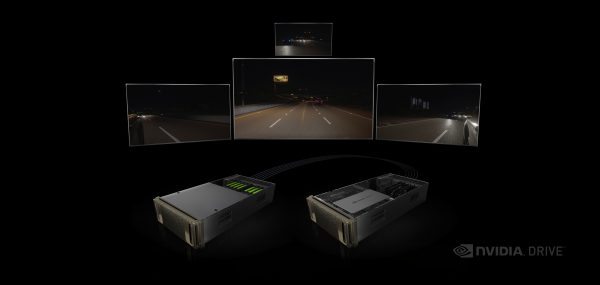NVIDIA Rolls Out a New Virtual Reality Autonomous Vehicle Simulator
Autonomous vehicle testing is getting a notch higher thanks to the Nvidia Drive Constellation simulation platform that allows you to test a self-driving vehicle in virtual reality.
If there is any lesson to be learnt from the latest Tesla Model X car crash, it is that you can never test an autonomous car enough. There are just too many scenarios and variables out there that an artificial intelligence system has to train for in order to deliver a higher standard of reliability and safety. For manufacturers, the biggest challenge is the limitation of the testing time and testing cost on the highways.
Nvidia has driven around this barrier by designing a cloud-based system that gives the designers and car testers a virtual reality simulation platform that will be able to test the artificial intelligence of the cars by driving them through billions of miles in various VR simulation scenarios.
The photorealistic simulation is geared at creating a safer and more scalable way of bringing reliable autonomous cars into our roads a lot faster.
The VR self-driving car simulation platform is called Nvidia Drive Constellation and it also incorporates the Nvidia DRIVE Pegasus. The platform runs on the DRIVE Sim software that is applied in the testing and the validation of autonomous car systems.

The simulation system will run on two servers. One of the servers will be running the Nvidia Drive Sim software whose function will be the simulation of the autonomous vehicle sensors such as the radar, lidar and the cameras. This will be the simulation server and its purpose will be to generate the simulated sensor data and feed it into the Nvidia Drive Pegasus AI for processing.
The second server will be running the Nvidia Drive Pegasus AI car computing system that is responsible for running the driverless car software architecture. This server will be processing the simulated data from the virtual reality environment which will be fed into it as if it is coming from the sensors of an actual car on the road.
The driving commands that are generated by the computing system in the Drive Pegasus are subsequently fed back to the simulation server thereby finishing the digital feedback loop. It is a hardware-in-the-loop cycle that runs thirty times per second and is deployed in validating that the software and the algorithms running on Pegasus are driving the simulated vehicle without any errors.
This application of virtual reality in autonomous vehicle simulation enables the testing and validation of the vehicle AI over billions of miles thus allowing the manufacture to realize a higher standard of safety and reliability that customers expect.
The Nvidia Drive Constellation achieves this by combining the company’s experience in datacenters and visual computing. Through the virtual reality simulation, the company is able to strengthen the robustness of its algorithms by testing the autonomous vehicles over billions of miles and multiple custom scenarios and corner cases while taking the fraction of time and cost that it would have required to test the real vehicles on the roads.
The Nvidia Sim software is capable of generating photoreal data streams that simulate different sensing environments that you are likely to encounter on physical roads such as snowstorms, blinding glares, rainstorms, limited vision at night as well as various kinds of road surfaces that are likely to exist in the real world. It is even possible to script various dangerous scenarios into the platform and use these to test the vehicle AI’s system ability to respond to these scenarios and keep the occupants safe.
The Drive Constellation enables a thorough a testing and validation over a large range of testing environments and is a step closer towards realizing fully driverless cars. The Drive Constellation will be available in third quarter of 2018 to the company’s early access partners.
Watch NVIDIA DRIVE Constellation
https://virtualrealitytimes.com/2018/03/29/nvidia-rolls-out-a-new-virtual-reality-autonomous-vehicle-simulator/https://virtualrealitytimes.com/wp-content/uploads/2018/03/NVIDIA_DRIVE_Constellation-600x285.jpghttps://virtualrealitytimes.com/wp-content/uploads/2018/03/NVIDIA_DRIVE_Constellation-150x90.jpgSimulationsSoftwareAutonomous vehicle testing is getting a notch higher thanks to the Nvidia Drive Constellation simulation platform that allows you to test a self-driving vehicle in virtual reality. If there is any lesson to be learnt from the latest Tesla Model X car crash, it is that you can never test...Sam OchanjiSam Ochanji[email protected]EditorVirtual Reality Times - Metaverse & VR
